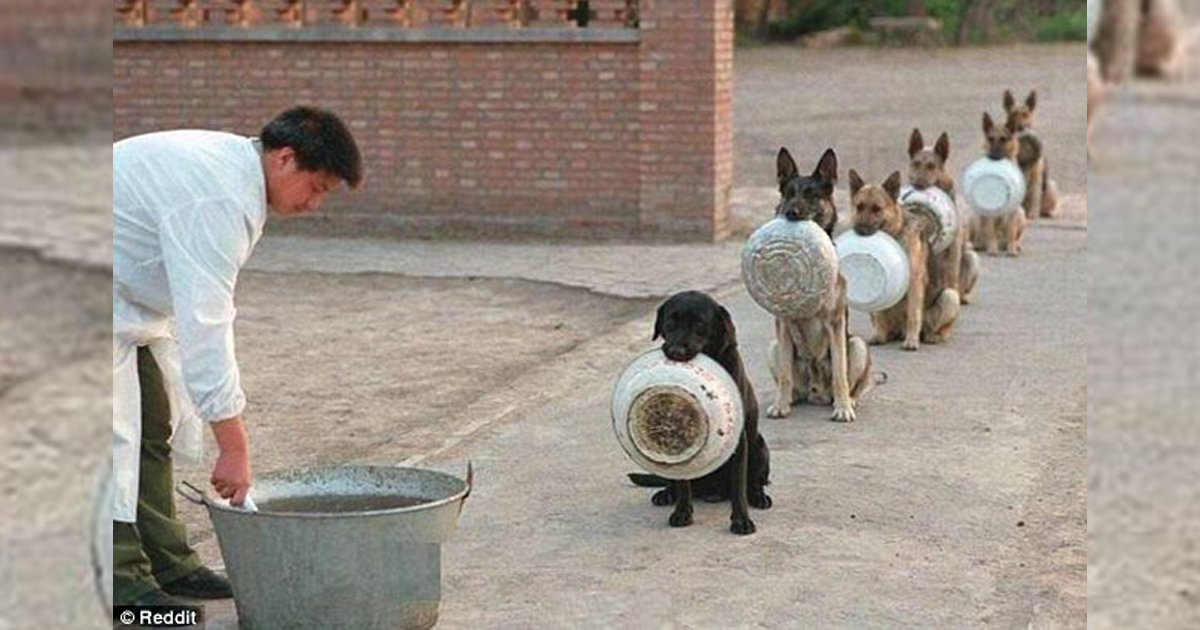In the quiet outskirts of a small town in southern Missouri, just where the paved road dissolves into gravel and wildflowers frame every fencepost, something remarkable was happening each morning.
It began, as all beautiful things do, in silence.
A line of dogs, some shaggy, some lean, some just pups, others grizzled with age, would begin to gather near an old barn at the break of dawn. They came not barking, not fighting, but with bowls held delicately in their mouths. One by one, they formed a line—tidy, patient, unprompted.
The caretaker was a woman named Ellie Mae Harmon, a retired nurse who had spent most of her life giving more than she ever received. After losing her husband and son in a car crash nearly a decade ago, Ellie Mae had slipped into a quiet solitude. Her heart ached, but her hands still needed purpose. One rainy morning, she found a soaking-wet stray puppy shivering under her porch.
She fed him, dried him off, and named him Lucky.
From that day on, the strays started coming.

Word seemed to spread across the woods and fields. Ellie Mae never turned any away. With what little money she had from her late husband’s pension, she bought kibble in bulk, mixed in leftovers from her own table, and greeted them with a soft smile and a gentle voice. Over time, the dogs began arriving with bowls—some plastic, some metal, some chewed at the corners—as if to say, *”I belong here too.”
The routine became sacred. At exactly 6:30 a.m., no matter the season, Ellie Mae would open the barn doors and the line would already be waiting. Not once did a dog push forward. Not once did she have to raise her voice. They waited, tails gently wagging, eyes locked on her with unwavering trust.
Passersby were stunned.
A truck driver first posted a video. It showed a line of more than twenty dogs, each holding their bowl, standing silently under the rising sun. The caption read: “Never seen anything like this. Bless this woman.”
That video went viral.
Within days, news crews showed up. Local stations, then national networks. Social media exploded with hashtags like #EllieAndTheDogs and #WaitingWithBowls. Donations poured in. Pet food companies offered supplies. A nearby veterinarian volunteered free health checks for the animals.

But Ellie Mae never sought the attention.
She was proud, humble, and most of all, focused. “They saved me as much as I saved them,” she told a reporter, eyes misty but firm. “They gave me a reason to get up again. To smile again.”
And they did.
Each dog had a story. Bruno, the three-legged shepherd mix, who had been hit by a truck. Sadie, the terrier who once had cigarette burns on her back. Max, the blind Labrador, who always managed to find his way to the end of the line by scent alone.
They all found a home—not behind fences or locked gates, but in Ellie Mae’s yard, under her trees, beside her rocking chair. She knew each one by name. They knew her by heart.
Locals began to help. Teenagers built wooden shelters around the property. Families brought blankets, medicine, and chew toys. The town of Hollow Creek, once fading on the map, became a symbol of something enduring: compassion without condition.
What struck people most wasn’t just the orderliness of the dogs, or the sheer discipline they displayed—it was the dignity. The quiet understanding that they were cared for. That someone saw them. That someone waited for them.
Photos of the line—bowls in mouths, tails wagging in perfect unison—adorned billboards, calendars, even murals. Schoolteachers shared the story in classrooms. Artists painted it. Musicians wrote songs.
And still, every morning, they came.
Rain. Snow. Sweltering heat. It didn’t matter.
At 6:30, the line would form.
And Ellie Mae would be waiting.
One December morning, Ellie Mae didn’t open the barn doors.
The dogs waited. Ten minutes passed. Then twenty.
Neighbors, sensing something was wrong, came to check. They found her in her bed, clutching a framed photo of her late son, her expression peaceful. She had passed in her sleep.
The town mourned.
The dogs gathered at her porch, bowls still in their mouths. Not barking. Not eating. Just sitting.
A week later, the community stepped up. Volunteers organized a rotation. The line of dogs continued, now fed by the hands of those who once watched from a distance.
They renamed the barn Ellie’s Place.
A bronze statue of Ellie Mae was unveiled later that spring. It shows her holding a scoop of food, leaning down, as one dog looks up—bowl in mouth, tail mid-wag.
The plaque reads:
“She fed them with her hands. But loved them with her soul.”
Even now, years later, the tradition endures. The dogs still line up. Tourists visit to witness the sight. And locals teach their children not just about the dogs—but about the woman who turned grief into grace.
Because in a world so often loud with cruelty, one woman’s quiet kindness taught us what it means to wait in line—with hope in your mouth and love in your heart.
